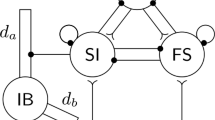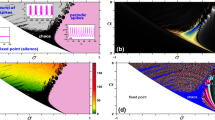Abstract
We analyze the behavior of a two-variable biochemical model in conditions where it admits multiple oscillatory domains in parameter space. The model represents an autocatalytic enzyme reaction with input of substrate both from a constant source and from non-linear recycling of product into substrate. This system was previously studied for birhythmicity, i.e. the coexistence between two stable periodic regimes (Moran and Goldbeter 1984), and for multithreshold excitability (Moran and Goldbeter 1985). When two distinct oscillatory domains obtain as a function of the substrate injection rate, the system is capable of exhibiting two markedly different modes of oscillations for slightly different values of this control parameter. Phase plane analysis shows how the multiplicity of oscillatory domains depends on the parameters that govern the underlying biochemical mechanism of product recycling. We analyze the response of the model to various kinds of transient perturbations and to periodic changes in the substrate input that bring the system through the two ranges of oscillatory behavior. The results provide a qualitative explanation for experimental observations (Jahnsen and Llinas 1984b) related to the occurrence of two different modes of oscillations in thalamic neurones.
Similar content being viewed by others
References
Frenkel R (1968) Control of reduced diphosphopyridine nucleotide oscillations in beef heart extracts. I. Effects of modifiers of phosphofructokinase activity. Arch Biochem Biophys 125:151–156
Gerisch G, Wick U (1975) Intracellular oscillations and release of cyclic AMP from Dictyostelium cells. Biochem Biophys Res Commun 65:364–370
Goldbeter A (1980) Models for oscillations and excitability in biochemical systems. In: Segel LA (ed) Mathematical models in molecular and cellular biology. Cambridge University Press, Cambridge, pp 248–291
Goldbeter A, Caplan SR (1976) Oscillatory enzymes. Annu Rev Biophys Bioeng 5:449–476
Goldbeter A, Nicolis G (1976) An allosteric enzyme model with positive feedback applied to glycolytic oscillations. In: Snell F, Rosen, R (eds) Progress in theoretical biology, vol 4. Academic Press, New York, pp 65–160
Goldbeter A, Martiel JL, Decroly O (1984) From excitability and oscillations to birhythmicity and chaos in biochemical systems. In: Ricard J, Cornish-Bowden A (eds) Dynamics of biochemical systems. Plenum Press, New York, pp 173–212
Hess B, Boiteux A (1968) Control of glycolysis. In: Järnefelt J (ed) Regulatory functions of biological membranes. Elsevier, Amsterdam, pp 148–162
Hess B, Boiteux, A (1971) Oscillatory phenomena in biochemistry. Annu Rev Biochem 40:237–258
Jahnsen H, Llinas, R (1984a) Electrophysiological properties of guinea-pig thalamic neurones: an in vitro study. J Physiol 349:205–226
Jahnsen H, Llinas, R (1984b) Ionic basis for the electroresponsiveness and oscillatory properties of guinea-pig thalamic neurones in vitro. J Physiol 349:229–247
Llinas R (1984) Rebound excitation and the physiological basis for tremor: a biophysical study of the oscillatory properties of mammalian central neurones in vitro. In: Findley LJ, Capildeo R (eds) Movement disorders: Tremor. Macmillan, London, pp 165–182
Llinas R, Yarom Y (1981) Properties and distribution of ionic conductances generating electroresponsiveness of mammalian inferior olivary neurones in vitro. J Physiol 315:569–684
Llinas R, Yarom Y (1986) Oscillatory properties of guinea-pig inferior olivary neurones and their pharmacological modulation: an in vitro study. J Physiol 376:163–182
Minorsky N (1967) Nonlinear oscillations. Van Nostrand, Princeton, NJ
Monod J, Wyman J, Changeux JP (1965) On the nature of allosteric transitions: a plausible model. J Mol Biol 123: 88–118
Moran F, Goldbeter A (1984) Onset of birhythmicity in a regulated biochemical system. Biophys Chem 20:149–156
Moran F, Goldbeter A (1985) Excitability with multiple thresholds: a new mode of dynamic behavior analyzed in a regulated biochemical system. Biophys Chem 23:71–77
Nicolis G, Prigogine I (1977) Self-organization in nonequilibrium systems. John Wiley, New York
Rose RM, Hindmarsh JL (1985) A model for a thalamic neuron. Proc R Soc Lond B 225:161–193
Winfree AT (1980) The geometry of biological time. Springer, New York Berlin Heidelberg
Author information
Authors and Affiliations
Rights and permissions
About this article
Cite this article
Goldbeter, A., Moran, F. Dynamics of a biochemical system with multiple oscillatory domains as a clue for multiple modes of neuronal oscillations. Eur Biophys J 15, 277–287 (1988). https://doi.org/10.1007/BF00256478
Received:
Accepted:
Published:
Issue Date:
DOI: https://doi.org/10.1007/BF00256478




